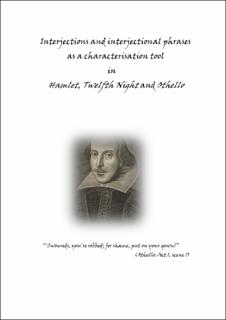| dc.contributor.advisor | Stenroos, Merja Riita | |
| dc.contributor.author | Rolfsnes, Mari | |
| dc.date.accessioned | 2020-08-04T11:56:30Z | |
| dc.date.available | 2020-08-04T11:56:30Z | |
| dc.date.issued | 2020-05-11 | |
| dc.identifier.uri | https://hdl.handle.net/11250/2670782 | |
| dc.description | Master's thesis in Literacy studies | en_US |
| dc.description.abstract | Abstract
Having mostly escaped scholarly scrutiny, interjections have in recent years received more attention and are currently being fronted and championed in linguistic research. However, there does not seem to be much research on how interjections and interjectional phrases are used in characterisation in historical play-texts. Interjections play a major role in the communication of feelings and of identity, choices of interjection often being closely linked to specific social groups. They are therefore ideal in signalling character and in the negotiation of meaning-making between stage and audience.
The present study enquires into the use of interjections and interjectional phrases as a characterisation tool in Shakespeare’s Hamlet, Twelfth Night and Othello and investigates how interjections and interjectional phrases may have assisted role inhabitation and character interpretation in late Elizabethan playhouses. Three main questions are addressed: what kind of interjections and phrases are used in the plays, how interjections and phrases convey character information, and whether interjections are used intentionally in the plays.
The collected data in the present study comprises primary and secondary interjections and interjectional phrases. These have collected from the First Folio (1623) edition of the Hamlet, Twelfth Night and Othello as it is generally agreed that the Folio is the most authoritative source for Shakespeare’s plays. In addition to the First Folio, the present study has used the Oxford edition of the plays as a control text. It provides modernised spelling and supplies expurgated readings from early quarto versions of the plays. The expurgated material is highly relevant for the present study as it consists of profane and offensive or potentially offensive interjections and interjectional phrases.
The data have been collected manually together with a range of different linguistic and extra-linguistic variables such as formal and functional category, pragmatic function, play, speaker and addressee gender and social status. Due to the context-boundedness of interjections, these and other linguistic and extra-linguistic variables are of vital importance in identifying interjection use and how interjections may assist character description in dramatic texts. Through an investigating of interjections and interjectional phrases on both the authorial and speaker discourse level, the present study finds that these words and phrases had their place in the toolbox that comprises linguistic characterisation devices available to playwrights of earlier times. | en_US |
| dc.language.iso | eng | en_US |
| dc.publisher | University of Stavanger, Norway | en_US |
| dc.relation.ispartofseries | Masteroppgave/UIS-HF-IKS/2020; | |
| dc.subject | Shakespeare | en_US |
| dc.subject | Early Modern English | en_US |
| dc.subject | literacy studies | en_US |
| dc.subject | lesevitenskap | en_US |
| dc.subject | interjections | en_US |
| dc.subject | characterisation | en_US |
| dc.title | Interjections and interjectional phrases as a characterisation tool in Hamlet, Twelfth Night and Othello | en_US |
| dc.type | Master thesis | en_US |
| dc.subject.nsi | VDP::Humaniora: 000::Språkvitenskapelige fag: 010 | en_US |
| dc.subject.nsi | VDP::Humaniora: 000::Litteraturvitenskapelige fag: 040 | en_US |
